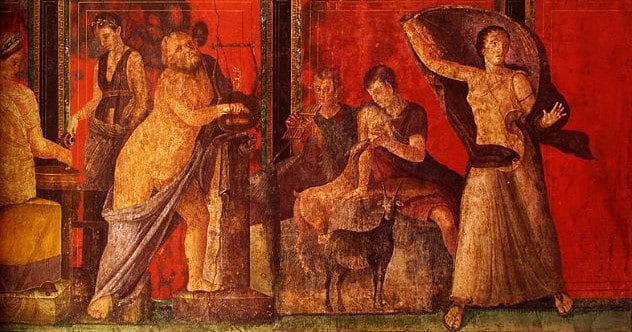Ancient Rome continues to captivate historians and archaeologists, offering a wealth of knowledge about its culture, citizens, and dominance. Yet, despite extensive documentation, numerous mysteries remain, leaving us to ponder the enigmas of this world-changing society.
Delve into ten unresolved questions about ancient Rome that continue to intrigue experts. Perhaps future discoveries will shed light on these puzzles, or maybe they will remain unsolved for eternity!
The Skulls of Walbrook Valley
In 2013, construction workers in London unearthed a collection of human skulls during the Crossrail project near Liverpool Street. These skulls were determined to be from the Roman period. Prior discoveries in the 1980s in Walbrook Valley had also revealed 39 Roman skulls.
The origin and disarticulation of these skulls remain a mystery. Theories range from the victims of Boudicca’s attack on Londinium in AD 60 to an ancient cemetery eroded over time. Other theories include mass murder or the practice of the “cult of the head,” where decapitated heads were used for rituals. Despite potential explanations, a conclusive answer remains elusive.
Mysterious Mithraism
Mystery cults in the Greco-Roman world kept their rituals secret, resulting in limited knowledge today. One such cult in Rome revolved around the god Mithras, possibly influenced by the Zoroastrian god Mithra. The exact connection is debated.
Mithraism emerged in Rome during the 1st century AD and spread rapidly. Devotees gathered in underground temples called mithraea, with over 400 ruins still standing. Despite its popularity, the absence of surviving texts about the cult’s rituals ensures that the Mithraic Mysteries remain an enigma.
Villa of the Mysteries
Outside Pompeii, the Villa of the Mysteries features remarkable frescoes. The villa has withstood the ravages of time and volcanic eruption. One room contains a continuous fresco wraparound with figures engaged in activities against a red backdrop.
The meaning of these frescoes remains elusive. Some scholars believe they offer a glimpse into a mystery cult, possibly associated with Dionysus. Other theories suggest they depict a bride on her wedding day or excerpts from a theatrical performance. The true significance of these artworks is still unknown.
The Hertfordshire Dodecahedron
In 1739, a Roman metal dodecahedron was discovered in Hertfordshire, England. Since then, over a hundred similar objects have been found across Europe. These dodecahedrons feature 12 faces, knobs on the edges, and varying-sized circular holes on each face.
The Romans left no written records of these items. Scholars have found no clues in historical texts. Theories suggest they were decorative pieces, measuring instruments, astronomical tools, or mystical objects. Without further evidence, the purpose of Roman dodecahedrons remains concealed.
The Puzzle of Silphium
Silphium was a highly valued herb in ancient Rome. It had medicinal, culinary, and aphrodisiac properties. Romans used it to treat ailments, flavor food, and even as birth control.
Unfortunately, silphium no longer exists, as the Romans are believed to have harvested it to extinction. Ancient writings document its remarkable properties. Some speculate that silphium still exists under a different name or was a hybrid herb unknown today. The true identity and potential return of silphium remain a mystery.
The Lost Roman Legion
The disappearance of Legio IX Hispana, an Imperial Roman Army legion, puzzles historians. The legion played a role in Caesar’s Gallic Wars and was stationed on the northern border of Britain until AD 109. By the reign of Marcus Aurelius, Legio IX Hispana was no longer listed among the Roman legions.
Theories suggest the legion was destroyed during a siege against the Picts in Scotland or during the Bar Kokhba Revolt in Judea. However, concrete proof is lacking. Evidence suggests the legion was present in Germania Inferior after AD 121. The fate of Legio IX Hispana remains uncertain.
Baiae’s Tunnels
Baiae was a resort town for wealthy Romans, later partially submerged due to volcanic activity. The Baiae Tunnels remain a mystery. These tunnels appeared as small, dark openings in a hillside, leading to narrow, hot passages.
In the 1960s, Robert Paget and Keith Jones explored the tunnels, revealing a labyrinth that Paget likened to a journey to the underworld described in Virgil’s Aeneid. While the tunnels likely served a ceremonial or religious purpose, their true significance is unknown.
The “Burrito” Sarcophagus
In Gabii, archaeologists discovered a unique sarcophagus dating back 1,700 years. This lead coffin weighed nearly 1,000 pounds and was folded over itself, resembling a “burrito.” The identity of the person inside remains a mystery.
Given the high value of lead, the coffin was likely for a priest, dignitary, or gladiator. Attempts to open it risk damaging the remains. The sarcophagus remains sealed, leaving its secrets in perpetual wonderment.
Chemical Warfare at Dura-Europos
During the Siege of Dura-Europos in 256 BC, the Romans and Sasanians clashed. The Sasanians dug tunnels beneath the town’s outer wall, prompting the Romans to respond with countermines.
The Sasanians ignited braziers containing pitch and sulfur, creating a lethal cloud of sulfur dioxide. This toxic cloud killed approximately 20 Roman soldiers, marking a potential early instance of chemical warfare. Details about the siege and its aftermath remain scarce, making this incident a pioneering yet mysterious moment in war history.
Titus Livius’s Work
Titus Livius, or Livy, documented Rome’s history in his 142-volume work, Ab Urbe Condita. The chronicle covered Rome’s history from its beginnings as a kingdom through its republican era.
Much of Livy’s work has been lost over time, with only 35 volumes recovered in their entirety. Condensed versions, such as The Periochae, gained popularity due to their accessibility. Rome’s historical legacy owes much to Livy’s efforts, but the missing fragments leave us wondering what knowledge has been lost.
Ancient Rome’s mysteries continue to fascinate and challenge historians. From unexplained skulls to lost legions, these unresolved questions provide a glimpse into the enduring enigmas of a remarkable civilization.
What do you think about these unresolved mysteries? Leave your comment below!










